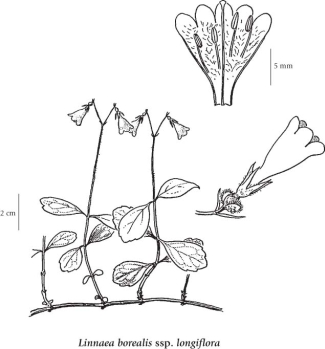Linnaea borealis subsp. longiflora L. (Torr.) Hultén
twinflower (longtube twinflower)
Caprifoliaceae (Valerian family)
Introduction to Vascular Plants
twinflower (longtube twinflower)
Caprifoliaceae (Valerian family)
Introduction to Vascular Plants
Map
Distribution of Linnaea borealis subsp. longiflora
Click here to view the full interactive map and legend
Species Information
General:
Evergreen, creeping, semiwoody herb or subshrub; stems long, slender, weakly rooting, thinly hairy and often also glandular, producing numerous short (less than 10 cm tall), more or less erect, leafy stems or branchlets with 2-4 pairs of leaves.
Leaves:
Opposite, simple, short-stalked, egg-shaped to nearly circular, with a few shallow teeth along the upper half, 7-25 mm long, 5-15 mm wide, leathery, dark green above, paler below, glabrous or the stalks and margins of the leaf bases often fringed with long hairs.
Flowers:
Inflorescence of nodding pairs of flowers on slender, erect, Y-shaped stalks that terminate the leafy branchlets; base of flowers cradled by two tiny bracts; corollas slenderly funnel-shaped, 9-16 mm long, pink to whitish, flaring above to 5 lobes, hairy in the throat; styles about as long as corollas, with a tiny knoblike stigma; stamens 4.
Fruits:
Dry 1-seeded achenes (nutlets), flanked by a pair of tiny glandular bracts.
Notes:
Two subspecies occur in BC:
1. Corollas 9-11 mm long, narrowly bell-shaped, flaring from within the calyces, tubes very short or sometimes absent................... ssp. borealis
1. Corollas 10-16 mm long, funnel-shaped, tubes about equalling or surpassing the calyces...................ssp. longiflora (Torr.) Hult.
Illustration

If more than one illustration is available for a species (e.g., separate illustrations were provided for two subspecies) then links to the separate images will be provided below. Note that individual subspecies or varietal illustrations are not always available.
Illustration Source: The Illustrated Flora of British Columbia
Habitat and Range
Mesic forests in the lowland and montane zones; ssp. longiflora common throughout BC; ssp. borealis infrequent in extreme NW BC; ssp. borealis - circumboreal, N to AK and YT, ssp. longiflora - N to AK, YT and NT, E to NF and S to IN, NM and CA.Status Information
Synonyms
Synonyms and Alternate Names:
Linnaea borealis subsp. americana (Forbes) Hultén ex R.T. Clausen
Linnaea borealis var. longiflora Torr.